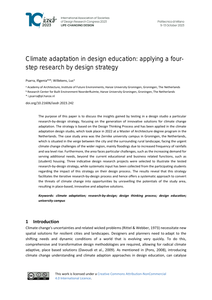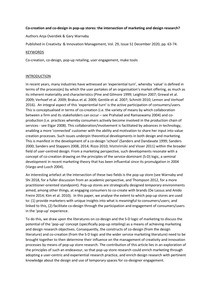from the article: "In this paper, we explore the characteristics of posters as an efficient and effective probing tool for hospital nurse participation in the development of processes, services or products. The main challenge in this respect is the limited time and attention available to nurses during their work shifts. For this, we analysed the design and effectiveness of posters from earlier projects and used existing knowledge on probing for preliminary guidelines focused on design elements, context of placement, and fit with work process. We then designed a poster for gathering insights during nurses’ work shifts into their administrative tasks and perceived relevance. To evaluate, this table poster design was consecutively placed on three nursing units in a Dutch hospital. Activities of nurses with the poster and necessary interventions were analysed and used for further insights into the characteristics of effective posters for this specific target group. The research raised new questions about how best to elicit nurses’ participation during work shifts."
LINK
Academic design research often fails to contribute to design practice. This dissertation explores how design research collaborations can provide knowledge that design professionals will use in practice. The research shows that design professionals are not addressed as an important audience between the many audiences of collaborative research projects. The research provides insight in the learning process by design professionals in design research collaborations and it identifies opportunities for even more learning. It shows that design professionals can learn about more than designing, but also about application domains or project organization.
DOCUMENT

(1) Background: Recent research showed that subtypes of patients with type 2 diabetes may differ in response to lifestyle interventions based on their organ-specific insulin resistance (IR). (2) Methods: 123 Subjects with type 2 diabetes were randomized into 13-week lifestyle intervention, receiving either an enriched protein drink (protein+) or an isocaloric control drink (control). Before and after the intervention, anthropometrical and physiological data was collected. An oral glucose tolerance test was used to calculate indices representing organ insulin resistance (muscle, liver, and adipose tissue) and β-cell functioning. In 82 study-compliant subjects (per-protocol), we retrospectively examined the intervention effect in patients with muscle IR (MIR, n = 42) and without MIR (no-MIR, n = 40). (3) Results: Only in patients from the MIR subgroup that received protein+ drink, fasting plasma glucose and insulin, whole body, liver and adipose IR, and appendicular skeletal muscle mass improved versus control. Lifestyle intervention improved body weight and fat mass in both subgroups. Furthermore, for the MIR subgroup decreased systolic blood pressure and increased VO2peak and for the no-MIR subgroup, a decreased 2-h glucose concentration was found. (4) Conclusions: Enriched protein drink during combined lifestyle intervention seems to be especially effective on increasing muscle mass and improving insulin resistance in obese older, type 2 diabetes patients with muscle IR.
DOCUMENT

The purpose of this paper is to discuss the insights gained by testing in a design studio a particular research-by-design strategy, focusing on the generation of innovative solutions for climate change adaptation. The strategy is based on the Design Thinking Process and has been applied in the climate adaptation design studio, which took place in 2022 at a Master of Architecture degree program in the Netherlands. The case study area was the Zernike university campus in Groningen, the Netherlands, which is situated in the verge between the city and the surrounding rural landscape, facing the urgent climate change challenges of the wider region, mainly floodings due to increased frequency of rainfalls and sea level rise. Furthermore, the area faces particular challenges, such as the increasing demand for serving additional needs, beyond the current educational and business related functions, such as (student) housing. Three indicative design research projects were selected to illustrate the tested research-by-design strategy, while systematic input has been collected from the participating students regarding the impact of this strategy on their design process. The results reveal that this strategy facilitates the iterative research-by-design process and hence offers a systematic approach to convert the threats of climate change into opportunities by unravelling the potentials of the study area, resulting in place-based, innovative and adaptive solutions.
DOCUMENT

This paper argues that a first step in finding a sustainable solution for the pressing global issue of ‘waste’, is to consider waste a value attribution rather than a material condition. Doing so means a shift in focus from finding more efficient ways to ‘clean up the mess’ to changing the way in which value is attributed to things. The paper looks at a selection of recent literature on value systems to identify useful concepts and theory for a value-based solution to waste. Furthermore, art and design are proposed to explore and probe suchpotential solutions.
DOCUMENT

Co-creation as a concept and process has been prominent in both marketing and design research over the past ten years. Referring respectively to the active collaboration of firms with their stakeholders in value creation, or to the participation of design users in the design research process, there has arguably been little common discourse between these academic disciplines. This article seeks to redress this deficiency by connecting marketing and design research together—and particularly the concepts of co-creation and co-design—to advance theory and broaden the scope of applied research into the topic. It does this by elaborating the notion of the pop-up store as temporary place of consumer/user engagement, to build common ground for theory and experimentation in terms of allowing marketers insight into what is meaningful to consumers and in terms of facilitating co-design. The article describes two case studies, which outline how this can occur and concludes by proposing principles and an agenda for future marketing/design pop-up research. This is the peer reviewed version of the following article: Overdiek A. & Warnaby G. (2020), "Co-creation and co-design in pop-up stores: the intersection of marketing and design research?", Creativity & Innovation Management, Vol. 29, Issue S1, pp. 63-74, which has been published in final form at https://doi.org/10.1111/caim.12373. This article may be used for non-commercial purposes in accordance with Wiley Terms and Conditions for Use of Self-Archived Versions. LinkedIn: https://nl.linkedin.com/in/overdiek12345
MULTIFILE

Service design is literally the design of services. Service designers improve existing services or design completely new ones. Nothing new so far. Services have been around for centuries, and every service was conceived and designed by someone. However, service design takes a different angle; a different perspective as its starting point: it is a process of creative inquiry aimed at the experiences of the individual user. ‘Service design, insights from 9 case studies’ is the final publication of the Innovation in Services programme. During this programme, creative design agencies applied the methods of service design in nine different projects.
DOCUMENT

Design educators and industry partners are critical knowledge managers and co-drivers of change, and design graduate and post-graduate students can act as catalysts for new ideas, energy, and perspectives. In this article, we will explore how design advances industry development through the lens of a longitudinal inquiry into activities carried out as part of a Dutch design faculty-industry collaboration. We analyze seventy-five (75) Master of Science (MSc) thesis outcomes and seven (7) Doctorate (PhD) thesis outcomes (five in progress) to identify ways that design activities have influenced advances in the Dutch aviation industry over time. Based on these findings, we then introduce an Industry Design Framework, which organizes the industry/design relationship as a three-layered system. This novel approach to engaging industry in design research and design education has immediate practical value and theoretical significance, both in the present and for future research. https://doi.org/10.1016/j.sheji.2019.07.003 LinkedIn: https://www.linkedin.com/in/christine-de-lille-8039372/
MULTIFILE
